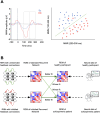Model-Based Approaches to Investigating Mismatch Responses in Schizophrenia
- PMID: 38751125
- PMCID: PMC11664892
- DOI: 10.1177/15500594241253910
Model-Based Approaches to Investigating Mismatch Responses in Schizophrenia
Abstract
Alterations of mismatch responses (ie, neural activity evoked by unexpected stimuli) are often considered a potential biomarker of schizophrenia. Going beyond establishing the type of observed alterations found in diagnosed patients and related cohorts, computational methods can yield valuable insights into the underlying disruptions of neural mechanisms and cognitive function. Here, we adopt a typology of model-based approaches from computational cognitive neuroscience, providing an overview of the study of mismatch responses and their alterations in schizophrenia from four complementary perspectives: (a) connectivity models, (b) decoding models, (c) neural network models, and (d) cognitive models. Connectivity models aim at inferring the effective connectivity patterns between brain regions that may underlie mismatch responses measured at the sensor level. Decoding models use multivariate spatiotemporal mismatch response patterns to infer the type of sensory violations or to classify participants based on their diagnosis. Neural network models such as deep convolutional neural networks can be used for improved classification performance as well as for a systematic study of various aspects of empirical data. Finally, cognitive models quantify mismatch responses in terms of signaling and updating perceptual predictions over time. In addition to describing the available methodology and reviewing the results of recent computational psychiatry studies, we offer suggestions for future work applying model-based techniques to advance the study of mismatch responses in schizophrenia.
Keywords: computational psychiatry; connectivity; decoding; mismatch negativity; schizophrenia.
Conflict of interest statement
Declaration of Conflicting InterestsThe authors declared no potential conflicts of interest with respect to the research, authorship, and/or publication of this article.
Figures




Similar articles
-
Auditory mismatch impairments are characterized by core neural dysfunctions in schizophrenia.Brain. 2015 May;138(Pt 5):1410-23. doi: 10.1093/brain/awv049. Epub 2015 Mar 4. Brain. 2015. PMID: 25743635 Free PMC article.
-
Neural substrates of normal and impaired preattentive sensory discrimination in large cohorts of nonpsychiatric subjects and schizophrenia patients as indexed by MMN and P3a change detection responses.Neuroimage. 2013 Feb 1;66:594-603. doi: 10.1016/j.neuroimage.2012.09.074. Epub 2012 Oct 22. Neuroimage. 2013. PMID: 23085112 Free PMC article.
-
Visual Mismatch and Predictive Coding: A Computational Single-Trial ERP Study.J Neurosci. 2018 Apr 18;38(16):4020-4030. doi: 10.1523/JNEUROSCI.3365-17.2018. Epub 2018 Mar 26. J Neurosci. 2018. PMID: 29581379 Free PMC article.
-
A computational approach to prefrontal cortex, cognitive control and schizophrenia: recent developments and current challenges.Philos Trans R Soc Lond B Biol Sci. 1996 Oct 29;351(1346):1515-27. doi: 10.1098/rstb.1996.0138. Philos Trans R Soc Lond B Biol Sci. 1996. PMID: 8941963 Review.
-
Steady state responses: electrophysiological assessment of sensory function in schizophrenia.Schizophr Bull. 2009 Nov;35(6):1065-77. doi: 10.1093/schbul/sbp091. Epub 2009 Sep 2. Schizophr Bull. 2009. PMID: 19726534 Free PMC article. Review.
Cited by
-
Increasing the Construct Validity of Computational Phenotypes of Mental Illness Through Active Inference and Brain Imaging.Brain Sci. 2024 Dec 19;14(12):1278. doi: 10.3390/brainsci14121278. Brain Sci. 2024. PMID: 39766477 Free PMC article. Review.
References
-
- Näätänen R, Gaillard AW, Mäntysalo S. Early selective-attention effect on evoked potential reinterpreted. Acta Psychol. 1978;42(4):313-329. - PubMed
Publication types
MeSH terms
LinkOut - more resources
Full Text Sources
Medical

